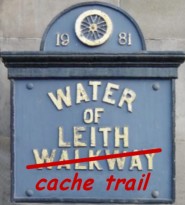
The inspiration for this cache came from a recent BBC TV Drama
The Reichenbach Falls. I won't spoil the story for those that
haven't seen it, but it was based around Edinburgh on an idea by
Ian Rankin and this particular landmark featured.
St Bernard’s Well is found on the Water of Leith Walkway
between Dean Village and Stockbridge.
Externally it takes the form of a Roman doric rotunda with a
statue of Hygieia, the Greek goddess of health, cleanliness and
sanitation in the centre. The well itself is contained within.

It is named after St Bernard of Clairvaux,
founder of the Cistercian order in the 12th century, who is reputed
to have discovered it while living in a nearby cave. Apparently he
was feeling ill and was led to the spring by birds (so I guess they
discovered it really - brings a whole new meaning to The spring is
sprung, the grass is riz, I wonder where dem birdies is...). He
drank the water and after some days, as if by magic, recovered his
health. The surrounding area became known as St Bernards.
The well disappeared from the records for a while and was
supposedly rediscovered by three boys from Heriot's Hospital in
about 1760. In 1764 the water was very popular although likened to
tasting like the “washings of foul gunbarrels”. (That
makes me wonder how one would know what foul gunbarrel washings
would taste like...perhaps they drank that when they ran out of
ale?)
The current building was commissioned by the then owner of the
well, Lord Gardenstone (Francis Garden) in 1789. He was apparently
so impressed by the well’s effects that he employed architect
Alexander Nasmyth to design the new wellhouse that we see today.
The design was based on Sybils's Temple at Tivoli
The interior has a mosaic floor in terracotta and white with
ornate blue mosaic domed ceiling and gilded sun-face with pierced
ventilation holes. There is a white marble pump on which is the
inscription "Bibendo Valebis" - which means by drinking you will
become well - (as in better, rather than being transformed into a
well!)
The last private owner, William Nelson the publisher had the
well restored in 1887 by Thomas Bonnar and a new marble statue of
Hygeia was carved by D W Stevenson to replace the original Coade
stone (a type of ceramic) one that had become damaged.
Following Nelson's death his trustees offered the well to
Edinburgh Corporation as a gift. There is a plaque commemorating
this next to the well house.
Those with an interest in football might be curious to know that
a local football club was formed in 1874 that took its name from
the local area -
St Bernards FC They used the well as their logo. For part of
their existence their home ground was the Royal Gymnasium, where
another cache
The Royal Gym can be found. This same club went onto win the
Scottish Cup in 1895, defeating Hearts in the semi-final in a
replay and then going on to beat Renton at Ibrox in front of a
crowd of 12000, only 1000 of them from Edinburgh in the final.
The following year they went on to reach the semi-final again,
this time losing to Hearts. Ironically their greatest success was
also their undoing. Their best players were snapped up by the
bigger clubs and they slowly disappeared into oblivion, eventually
being wound up during the second world war.
The cache can be wheelchair and stroller accessed if approached
directly from Saunders Street on the lower path, thus avoiding the
steps down from the higher path.
It can also be reached directly from Leith Walkway if approached
from either end, by steps that lead down to a door under the
rotunda - which funnily enough is locked.
The cache container is a medium (shallow) lock box with room for
small swaps and travel bugs. Please use appropriate stealth. This
can be a busy area and features lots of passing muggles. Please
also make sure the cache is appropriately camouflaged when
rehiding.
Note - GPSr accuracy was poor when hiding - so the coords may be
a bit out - but the clue should help. It shouldn't be a difficult
find!
Thanks to a tip off from HH, I paid a quick visit for the
purposes of taking some photos of the interior. Since similar
images already appear in the gallery I shan't post them
separately.
The well is open from 11 a.m. to 3 p.m on Saturdays and Sundays
during the festival period and also on the annual doors open day -
so the timing of the placing of this cache was somewhat
serendipitous. As has been noted elsewhere, it's worth a visit.